Sudanese army gains ground in Khartoum, but war with RSF drags on
November 20, 2024 (KHARTOUM) – The Sudanese army has shifted its tactics in the battle for the capital, manoeuvring to outflank the Rapid Support Forces (RSF) in the city’s north. This new strategy follows a recent advance into the Al-Samrab neighbourhood of Khartoum Bahri, avoiding a risky direct assault on the RSF stronghold in the Shambat district.
After a six-week stalemate, the army, which has been positioned in Halfaya since late September, gained ground in Khartoum Bahri by seizing key areas in Al-Samrab, east of Halfaya. This move secures the army’s rear flank, protecting it from RSF counterattacks and movements from their positions east of the Nile River.
However, intense fighting continues in the Al-Muqran area of central Khartoum, with neither side gaining a clear advantage. While the army has been unable to replicate its success in Al-Samrabof Khartoum Bahri, it is holding ground against fierce RSF resistance in this strategically vital area, where the paramilitary force relies heavily on sniper fire.
The army launched a major ground offensive on September 26 to retake the capital, which has been under RSF control since the war erupted on April 15, 2023. This offensive, the first of its kind in the conflict, was preceded by an intense air campaign. The army has conducted 1,158 airstrikes over the past nine months, an average of 12.8 per day, with a peak in August after acquiring Russian fighter jets, ammunition, and Iranian drones.
The RSF, meanwhile, has targeted 157 locations, according to military sources who spoke to Sudan Tribune. Most of the strikes were in North Darfur, particularly El Fasher, as well as in Khartoum and parts of Sennar state.
Since the war began, the RSF has effectively deployed drones, striking targets in Khartoum, Darfur, Al Jazirah, and Sennar. The army initially relied on warplanes to break the siege of its bases, especially in Khartoum, but later acquired Iranian “Mohajer” drones after relations between the two countries resumed in October 2023.
Sources told Sudan Tribune that the army is now deploying CH-3 drones, which have a top speed of 160 miles per hour, a range of roughly 1,860 miles, a flight endurance of up to 12 hours, and a payload capacity of 400 pounds of surface-to-air missiles.
The RSF possesses long-range rocket launchers and, according to a source close to the group, is seeking to acquire an advanced air defence system and jamming technology. However, Sudan Tribune has noted a recent absence of RSF anti-aircraft activity.
Despite the escalating arms race, fighting in Khartoum has subsided in the past two weeks, with the intensity of the army’s ground offensive waning. Since the operation began on Sept. 26, army forces advancing from Omdurman have managed to cross the Al-Silah Al-Tibbi Bridge in the south and the Halfaya Bridge in the north, both key battlegrounds.
A military expert, speaking on condition of anonymity, told Sudan Tribune that the offensive slowdown is to be expected in urban warfare, where troops must advance cautiously. However, he warned that prolonged inactivity could allow the RSF to regroup and replenish its forces.
A November 14 field report, seen by Sudan Tribune, indicated a weak RSF presence in several Khartoum Bahri neighbourhoods, including Al-Sababi, Shambat, Al-Safiya, and Al-Shaabiya. The report attributed this to supply shortages and the departure of “South Sudanese mercenaries” and recommended that the army deploy all available forces across all axes in Khartoum.
An army source asked about the report’s recommendations and said troops were awaiting orders from commanders who have a comprehensive view of the battlefield. “While the army in Halfaya may see it as necessary to advance on all fronts, there might be intelligence from other areas that necessitates focusing on Kafouri or east of the Nile, for example,” the source said.
The source emphasized the unpredictable nature of urban combat, where surprise plays a crucial role and rapid advances are complicated when the opposing forces are evenly matched.
Military sources also revealed that the RSF has highly trained special units stationed at the Paratroopers Corps base in Khartoum Bahri. These units operate between the bridges and have repeatedly hampered the army’s progress.
The army aims to link its forces in Halfaya with the Signal Corps base south of the city. This would allow the army to reach its headquarters at the General Command and then push into the city centre, coordinating with forces in Al-Muqran.
According to an army source, the primary goal of the ground operation in Khartoum is to break the siege of the General Command.

